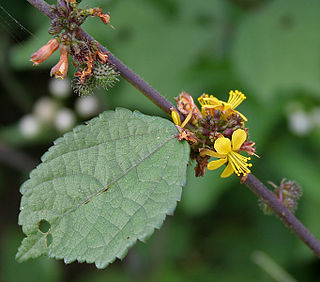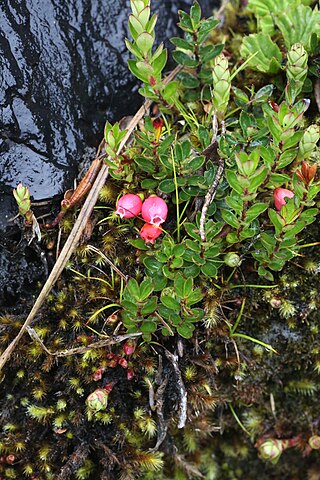
Sterculia is a genus of flowering plants in the mallow family, Malvaceae: subfamily Sterculioideae. Members of the genus are colloquially known as tropical chestnuts. Sterculia may be monoecious or dioecious, and its flowers unisexual or bisexual.

Alseis is a genus of flowering plants in the family Rubiaceae. It was described by Heinrich Wilhelm Schott in 1827. The genus is native to tropical Latin America from southern Mexico to Brazil.

Bertiera is a genus of flowering plants in the family Rubiaceae. It comprises 57 species with most known from tropical Africa, five known from various Indian Ocean islands and five found in the tropics of the Americas.

Helicostylis is a genus of plants in the family Moraceae.
Ladenbergia oblongifolia, many synonyms, including Ladenbergia gavanensis, is a species of plant in the family Rubiaceae. It is native to the north-west of South America: Bolivia, northern Brazil, Colombia, Ecuador, Peru and Venezuela.
Ladenbergia muzonensis, synonyms including Ladenbergia ulei, is a species of plant in the family Rubiaceae. It is native to north-western South America: Colombia, Ecuador, Peru and Venezuela.
Remijia is a genus of flowering plants in the family Rubiaceae. Within the family, it is a member of the subfamily Cinchonoideae and the tribe Cinchoneae.

Triumfetta is a genus of plants in the family Malvaceae. Burbark is a common name for plants in this genus.

Duroia is a genus of flowering plants in the family Rubiaceae. The genus is found from Costa Rica to tropical South America.

Alibertia is a genus of flowering plants in the family Rubiaceae. It is found in tropical America. They are dioecious trees or shrubs, with white flowers and indehiscent, often fleshy fruit.

Arcytophyllum is a genus of flowering plants in the family Rubiaceae. The genus contains 18 species, distributed from New Mexico to Bolivia.

The Cinchoneae are a tribe of flowering plants in the family Rubiaceae containing about 125 species in 9 genera. Representatives are found from Costa Rica to southern tropical America. Species within Cinchoneae are characterized as small trees or shrubs with imbricate or valvate corolla aestivation and often dry capsular fruits. Many species contain alkaloids.

Goeppertia is a genus of flowering plants in the family Marantaceae, native to the New World Tropics. It contains 243 accepted species, many of which were until recently assigned to Calathea. It was first described by Nees von Esenbeck in 1831, who erroneously erected another genus Goeppertia in 1836, which has now been synonymized with Endlicheria. In 1862 August Grisebach described another genus Goeppertia; this has now been synonymized with Bisgoeppertia.

Pentagonia is a genus of over 40 species of plants in the Coffee or Gardenia family (Rubiaceae}. Pentagonia species are native to Central America and northern South America, and grow in moist tropical forests below 900m. The genus was first described by George Bentham in 1845. The genus is noteworthy for its opposite pairs of huge leaves in a variety of shapes including entire, shallowly or deeply lobed, and even pinnate. These leaves can, in the case of a recently discovered species, be up to four feet long not including the six inch petiole, and up to 2.5 feet in width.

Condamineeae is a tribe of flowering plants in the family Rubiaceae and contains about 305 species in 31 genera. Most genera are found in Central and Southern Tropical America, but a few occur in Southeast Asia.

Ferdinandusa is a genus of flowering plants in the family Rubiaceae, native to the American tropics.

Amphilophium is a genus of flowering plants in the family Bignoniaceae, native to South America. Amphilophium crucigerum has escaped from cultivation elsewhere, and has become an invasive weed in Australia.

Disterigma is a genus of flowering plants belonging to the family Ericaceae.
Hippotis is a genus of flowering plants belonging to the family Rubiaceae.














